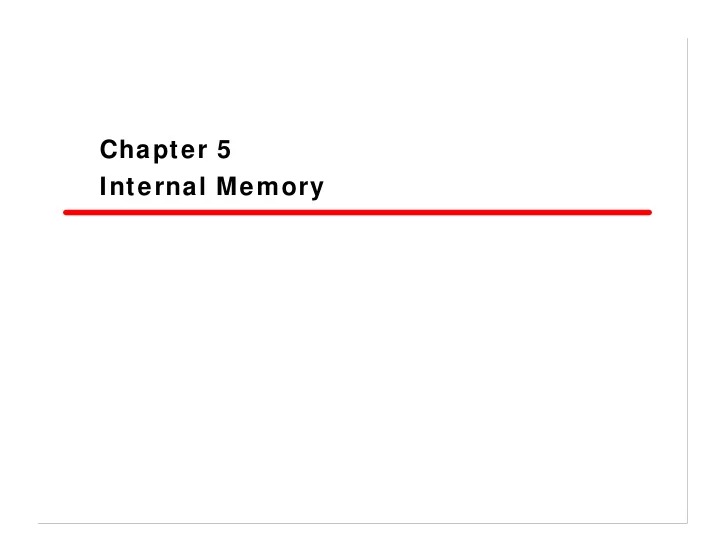

Chapter 5 Internal Memory
Contents • Semiconductor main memory —Organization —DRAM and SRAM —Types of ROM —Chip logic —Chip packaging —Module organization • Error correction • Advanced DRAM organization —Synchronous DRAM —Rambus DRAM —Cache DRAM
5.1 Semiconductor Main Memory • Memory cell —Basic element of a semiconductor memory —Properties – exhibit two stable states for 1 and 0 – can be written into – can be read from
Memory Cell Operation
Semiconductor Memory Types
Semiconductor Memory • RAM —Misnamed as all semiconductor memory is random access —Read/Write —Volatile —Temporary storage —Dynamic or Static
Dynamic RAM • Bits are stored as charge in capacitors —Capacitors have tendency to discharge —Need refreshing even when powered • Simpler construction(Fig 5.2(a)) —Smaller circuit per bit —Less expensive • Need refresh circuits —Slower • Used for main memory • Essentially analogue device —Level of charge determines value
Dynamic RAM(DRAM) Cell
DRAM Operation • Address line active when bit read or written —Transistor switch closed (current flows) • Write —Voltage to bit line – High for 1 and low for 0 —Then signal address line – Transfers charge to capacitor • Read —Address line selected – transistor turns on —Charge from capacitor fed into the bit line – Compared with reference value to determine 0 or 1 —Capacitor charge must be restored
Static RAM • Bits are stored as on/off switches —No charges to leak —No refreshing needed when powered • More complex construction —Larger circuit per bit —More expensive • Does not need refresh circuits —Faster • Used for cache • Digital device —Uses flip-flops
Static RAM Operation • Transistor arrangement gives stable logic state —State 1 – C 1 high and C 2 low – T 1 T 4 off and T 2 T 3 on —State 0 – C 1 low and C 2 high – T 1 T 4 on and T 2 T 3 off • Transistors T 5 T 6 works as a switch —A signal applied, switch is on • Write – apply value to B & compliment to B • Read – value is on line B
Static RAM(SRAM) Cell
SRAM vs DRAM • Both volatile —Power needed to preserve data • Dynamic cell —Simpler to build, smaller —More dense —Less expensive —Needs refresh —Used for larger memory units • Static cell —Faster —Cache
Read Only Memory (ROM) • Permanent storage —Nonvolatile • Applications —Microprogramming —Library subroutines —Systems programs (BIOS) —Function tables
Types of ROM • Programmable ROM(once) —PROM —Needs special equipment to program • Read “mostly” memory —Erasable Programmable (EPROM) – Before the write, all memory cells must be erased – Erased by UV light —Electrically Erasable (EEPROM) – Only the needed bytes can be updated – More expensive and less dense than EPROM —Flash memory – Possible to erase just blocks of memory(but not byte level) – Uses one transistor per bit(like EPROM)
Chip Logic • Organization of a 16 Mbit chip —Can be organized as 1M of 16 bit words —Can be organized as one-bit-per-chip —Can be in between • A 16 Mbit chip as a 2048 x 2048 x 4 bit array —Multiple DRAMs are connected to the controller to read/write a word —Reduced number of address pins – Multiplex row address and column address – 11 pins to each address (2 11 = 2048) – Adding one more pin doubles range of values so x4 capacity
Refreshing • Refresh circuit included on chip • Refresh operation —Disable the chip —Count through all rows – For each row, data are read out and written back into the same location • Takes time • Slows down performance
Typical 16 Mb DRAM (4M x 4)
Memory Package Pins and Signals
Module Organization (1) A memory module of 256K 8-bit words
A memory module Module Organization (2) of 1M 8-bit words
5.2 Error Correction • Memory system is subject to errors —Hard failure – permanent physical defect —Soft failure – random, non-destructive event that alters the contents of memory cells • Error-correcting/Error-detecting codes —Using some redundancy in data representation, we can correct/detect errors
Error Correcting Code Function Text book, pages: 149 to 153
5.3 Advanced DRAM Organization • Basic DRAM remains same since first RAM chips • Enhanced DRAMs —SDRAM —RDRAM —CDRAM
Synchronous DRAM (SDRAM) • Access in a typical DRAM —Address is presented to RAM —After access-time delay, DRAM reads/writes —Processor simply waits through this delay • Access in SDRAM —Synchronized to an external clock —Address is presented to RAM —DRAM responds after a set number of clock cycles —CPU can do other tasks while SDRAM processing • Employs a burst mode —A series of data bits can be clocked out rapidly after the first bit has been accessed • DDR-SDRAM sends data twice per clock cycle
RAMBUS DRAM(RDRAM) • Adopted by Intel for Pentium & Itanium • Main competitor to SDRAM • Vertical package – all pins on one side —Data exchange over 28 wires < 12 cm long • RDRAM bus is used —Asynchronous block-oriented protocol —After 480ns initial access time, 1.6 GBps —Bus can address up to 320 RDRAM chips at 1.6 GBps
Cache DRAM(CDRAM) • Developed by Mitsubishi —Integrates a small SRAM cache(16 Kb) onto a generic DRAM chip • Cache usage —As a true cache —As a buffer to support the serial access of a block of data – (Ex) To refresh a bit-mapped screen, CDRAM can prefetch the data from DRAM into SRAM buffer
Recommend
More recommend